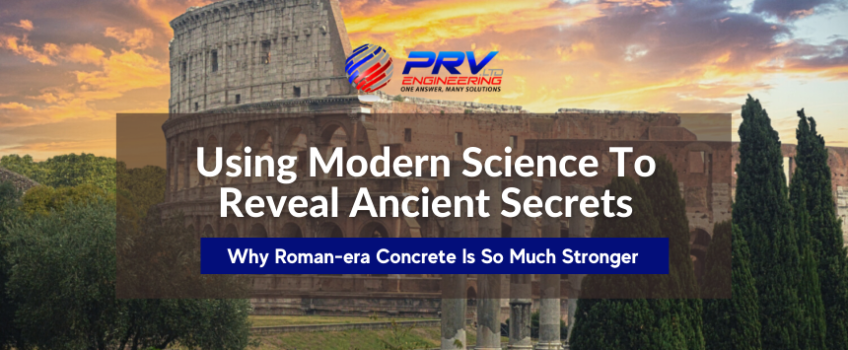
In construction, concrete is used to form the foundations, columns, beams, slabs and other load-bearing elements. Today’s concrete is strong, durable, versatile and economical but it doesn’t compare to concrete from the Roman era. A recent discovery may be able to provide the answer to why it was so much stronger.
What Is Concrete?
Concrete is a mass formed by the concretion or coalescence of separate particles in one body. It’s a hard, strong building material made by mixing a cementing material and a mineral aggregate (sand and gravel) with enough water to bind the entire mass.
The Strength Of Roman-era Concrete
The Massachusetts Institute of Technology (MIT) has conducted a study of a 2,050-year-old Roman tomb with some fascinating information about the nature of Roman-era concrete. Although it’s an ancient technology, the durability of Roman concrete has long been a question that experts could finally answer.
A team studied some of the existing Roman concrete structures and made some interesting findings as to why it lasts so much longer. In contrast to modern concrete that tends to crack and crumble after a few decades through a process called spalling, Roman concrete seems different.
Invented before modern material science, it appears to last for centuries without facing the same issues. More often than not, many existing Roman concrete structures are in great condition considering their age. It’s an engineering feat that modern concrete recipes cannot replicate, at least not yet.
Analysing Roman Concrete
The MIT study focussed on a well-preserved tomb of a Roman noblewoman, The Tomb of Cecilia Metella and Castrum Caetani ruins in Rome. After they analysed the concrete in detail, it appears the secret could involve using volcanic aggregate and how it reacted to rain and groundwater over the ages.
The tomb in itself is located on the Appian Way in Rome, a landmark on the Via Appia Antica. It’s a rotunda-shaped tower that sits on a square base standing about 70 feet (21 meters) tall and 100 feet (29 meters) wide. Experts believe they built the tomb around 30 BCE around the same time Emperor Augustus transformed the Roman Republic into an empire.
Admir Masic, associate professor of civil and environmental engineering at MIT said: “Understanding the formation and processes of ancient materials can inform researchers of new ways to create durable, sustainable building materials for the future.”
Advanced Roman Construction
To build the tomb, they used a very sophisticated method of construction at the time and a technique described by the famous Roman architect, Vitruvius.
The thick walls were made from coarse brick or volcanic rock aggregate, each bound with mortar consisting of lime and volcanic tephra – porous fragments of glass and crystals from explosive eruptions. According to Vitruvius, this would result in structures that do not fall into ruins after a long time.
They found that the secret behind longer-lasting Roman concrete might be related to a mineral called leucite. This mineral is rich in potassium that dissolves over time and effectively remodels the binding process. This improves the cohesion of concrete to make it stronger and improve durability by some margin.
Investigating The Microstructure Of The Concrete
Considering the sheer number of well-preserved Roman concrete structures still standing today, this study could prove vital in many ways. This led another member of the team, Linda Seymour to investigate the structure of the concrete using scientific tools.
They used SEM (Scanning Electron Microscopy) and to show the microstructures of the mortar at the micron scale. At the same time, using Energy Dispersive X-ray Spectrometry allowed them to determine the elemental composition.
Seymour stated that “this information allows us to explore different areas in the mortar quickly, and we could pick out building blocks related to our questions. The trick is to precisely hit the same building block target with each instrument when that target is only about the width of a hair.”
You can find the recently published study in the Journal of the American Ceramic Society.
Using Modern Science To Reveal Ancient Secrets
The study of the concrete walls shows that the mortar contained volcanic tephra similar to the mortar used in the Markets of Trajan built 120 years later. This “glue” consists of a building block called the C-A-S-H binding phase (calcium-aluminium-silicate-hydrate) as well as strätlingite crystals.
However, as mentioned earlier, the tephra used in building the tomb is much richer in leucite. As you can imagine, the tomb walls were exposed to rain and groundwater over the centuries which would dissolve the leucite releasing more and more potassium into the mix.
Today, this presents a problem as an abundance in modern concrete creates expansive gels that would cause micro-cracking. This would eventually result in the structure deteriorating but not for the tomb walls. Here, the dissolved potassium essentially reconfigured the C-A-S-H binding phase resulting in superior characteristics.
Conclusion
Based on the study, construction in the Roman era seemed to be more advanced than many of us may realise. The results could lead to modern concrete becoming even stronger and more durable than ever.
According to Masic: “It turns out that the interfacial zones in the ancient Roman concrete of the tomb of Caecilia Metella are constantly evolving through long-term remodelling. These processes reinforce interfacial zones and potentially contribute to improved mechanical performance and resistance to failure of the ancient material.”
“The tomb of Caecilia Metella is one of the oldest structures still standing, offering insights that can inspire modern construction.”
For more interesting articles on engineering, manufacturing and technology, please follow our blog and join the conversation on social media using the hashtag #PRVtech. Visit the website if you’d like to know more about PRV’s role in several sectors, including construction, rail, defence and aerospace among others.


 Mail:
Mail: 



